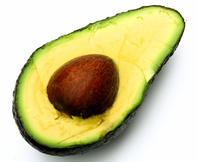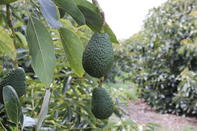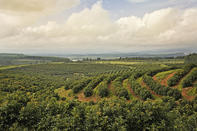A versatile and nutritious fruit, avocados are produced in the humid, subtropical regions of South Africa, most notably the Limpopo and Mpumalanga provinces during the months of March to September.

What is an Avocado
Avocado (Persea americana) is also known as alligator pear, aguacate and palta in Spanish, or avokado in Afrikaans. Praised by ancient Central American civilisations for its nutritional and aphrodisiac properties, the name ‘avocado’ may be derived from the Aztec word ‘ahuacatl’ meaning ‘testicle’.
The avocado is a subtropical, nutrient-rich fruit with green skin and a single hard pip. The light-green to cream-coloured buttery flesh contains dietary fibre (the highest of any fruit), monounsaturated fat and more than 20 vitamins. Avocados also contain folate, vitamin K, pantothenic acid and copper as well as 6% of the recommended daily value for vitamin E, 4% for vitamin C and carotenoids: lutein and zeaxanthin.
Avocados are mostly eaten fresh and can be processed to yield an excellent quality mono-unsaturated oil, avocado pulp, which is mostly used to prepare guacamole and can also be cut in pieces and quick-frozen.

Production of Avocados
The fast-growing avocado tree is a dense, evergreen tree suited to cool and humid conditions of subtropical climates. The tree is sensitive to frost and water stress - annual rainfall of 1 000 mm is desirable.
Clumps of 200 - 300 yellow-green flowers appear in summer months and are pollinated by bees and hoverflies, but only two or three flowers develop into a fruit.
Avocados do not ripen while on the tree and must be picked when large and fully grown. It will ripen within one to two weeks at room temperature and must not be kept at temperatures lower than 5.5°C. Ripening can be managed by controlled atmosphere storage and transport.

History of the Avocado
The avocado is thought to have originated in Mexico from where cultivation may have spread southwards through Central America to Peru and then to the West Indies. Its introduction to the rest of the world was most probably facilitated by European traders around 1519.
Similarly, it is believed that the first avocado seedlings were brought to South Africa either by traders or early settlers. Vegetative propagation of avocados began in America in the 1890s and the first commercial plantings were started in Israel in 1908, with the first-named cultivars: Fuerte and Dickinson, planted in 1924.
History of Avocado Production in South Africa

The production of avocados in South Africa started in the 1930s by Dr Hans Merensky who established the first avocado orchards at Westfalia Estate in the Limpopo Province. This company’s technical division: Westfalia Technological Services (WTS), has now become the world's largest privately-funded subtropical fruit research organisation.
The South African Avocado Growers Association (SAAGA) was established in the late 1960s to improve production and marketing of avocados. SAAGAs membership of over 500 growers constitutes over 95% of South Africa’s avocado export production.
The South African avocado industry grew from 2 000 ha in the early 1970s to 12 000 ha in 2003. In January 2019, there was about 17 500 ha planted in South Africa with an estimated increase of at least 1 000 ha to 1 500 ha planted per year.
By Marinda Louw